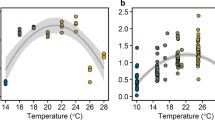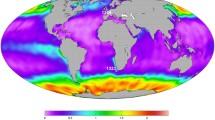Abstract
Pseudonitzschia seriata, isolated from sea ice in the Canadian Arctic, was grown in silicon-limited batch and semi-continuous culture to determine the effects of temperature on its nutrient utilization. Resource-saturated growth rate (μmax) increased significantly with temperature from -1.5 to 6°C with a Q10 of 1.63. The efficiency of the algae in using exogenous silicic acid for growth had no significant monotonic relationship with temperature but was significantly (P<0.05) greater in cultures at >0°C than in those at lower temperatures. Silicic acid uptake kinetics did not differ between high and low temperatures. Silicon cell quotas were significantly higher at temperatures <0°C, indicating greater silicon demand at low temperatures.P. seriata should not suffer silicon limitation in its natural ice habitat based on the observed kinetics, but its behaviour provides some support for the suggestion that temperatures <0°C are associated with diminished efficiency of nutrient utilization by cold ocean microalgae.
Similar content being viewed by others
References
Ahlgren G (1987) Temperature functions in biology and their application to algal growth constants. Oikos 49:177–190
Bevington CR (1969) Data reduction and error analysis for the physical sciences. Wiley, New York
Brand LE, Guillard RRL (1981) A method for the rapid and precise determination of acclimated phytoplankton reproduction rates. J Plankton Res 3:195–201
Conley DJ, Kilham SS (1989) Differences in silica content between marine and freshwater diatoms. Limnol Oceanogr 34:205–213
Conway HL, Harrison PJ (1977) Marine diatoms grown in chemostats under silicate or ammonium limitation. IV. Transient response ofChaetoceros debilis, Skeletonema costatum andThalassiosira gravida to a single addition of the limiting nutrient. Mar Biol 43:33–43
Cota GF, Horne EPW (1989) Physical control of ice algal production in the high Arctic. Mar Ecol Prog Ser 52:111–121
Cota GF, Anning JL, Harris LR, Harrison WG, Smith REH (1990) The impact of ice algae on inorganic nutrients in seawater and sea ice in Barrow Strait, NWT, Canada during spring. Can J Fish Aquat Sci 47:1402–1415
Dieckmann GS, Lange MA, Ackley SF, Jennings JC Jr (1991) The nutrient status in sea ice of the Weddell Sea during winter: effects of sea ice texture and algae. Polar Biol 11:449–456
Eppley RW (1972) Temperature and phytoplankton growth in the sea. Fish Bull 70:1063–1085
Gosselin M, Legendre L, Therriault JC, Demers S (1990) Light and nutrient limitation of sea ice microalgae (Hudson Bay, Canadian Arctic). J Phycol 26:220–232
Harrison PJ, Parslow JS, Conway HL (1989) Determination of nutrient uptake kinetic parameters: a comparison of methods. Mar Ecol Prog Ser 52:301–312
Healey FP (1980) Slope of the Monod equation as an indicator of advantage in nutrient competition. Microb Ecol 5:10–24
Jacques G (1983) Some ecophysiological aspects of the Antarctic phytoplankton. Polar Biol 2:27–33
Kilham SS (1984) Silicon and phosphorus growth kinetics and competitive interactions betweenStephanodiscus minutus andSynedra sp. Verh Int Verein Limnol 2:435–439
Kilham SS, Kott CL, Tilman D (1977) Phosphate and silicate kinetics for the Lake Michigan diatomDiatoma elongatum. J Great Lakes Res 3:93–99
Kottmeier ST, Sullivan CW (1988) Sea ice microbial communities (SIMCO).9. Effects of temperature and salinity on rates of metabolism and growth of autotrophs and heterotrophs. Polar Biol 8:293–304
Maestrini SY, Rochet M, Legendre L, Demers S (1986) Nutrient limitation of the bottom ice microalgal biomass (southeastern Hudson Bay, Canadian Arctic). Limnol Oceanogr 31:969–982
McMinn A, Gibson J, Hodgson D, Aschman J (1995) Nutrient limitation in Ellis Fjord, eastern Antarctica. Polar Biol 15:269–276
Mechling JA, Kilham SS (1982) Temperature effects on silicon limited growth of the Lake Michigan diatomStephanodiscus minutus (Bacillariophyceae). J Phycol 18:199–205
Morel FMM, Reuter JG, Anderson DM, Guillard RRL (1979) AQUIL: A chemically defined phytoplankton culture medium for trace metal studies. J Phycol 15:135–141
Nelson DM, Tréguer P (1992) Role of silicon as a limiting nutrient to Antarctic diatoms: evidence from kinetic studies in the Ross Sea ice edge zone. Mar Ecol Prog Ser 80:255–264
Paasche E (1980) Silicon content of five marine plankton diatom species measured with a rapid filter method. Limnol Oceanogr 25:474–480
Raven JA, Geider RJ (1988) Temperature and algal growth. New Phytol 110:441–461
Rhee GY, Gotham I (1981) The effect of environmental factors on phytoplankton growth: temperature and the interactions of temperature with nutrient limitation. Limnol Oceanogr 26:635–648
Smith REH, Anning J, Clement P, Cota GF (1988) Abundance and production of ice algae in Resolute Passage, Canadian Arctic. Mar Ecol Prog Ser 48:251–263
Smith REH, Stapleford LC, Ridings RS (1994) The acclimated response of growth, photosynthesis, composition and carbon balance to temperature in the psychrophilic ice diatomNitzschia seriata. J Phycol 30:8–16
Sommer U (1986) Nitrate and silicate competition among antarctic phytoplankton. Mar Biol 91:345–351
Stapleford LS (1994) The effects of temperature and silicon on the psychrophilic diatomNitzschia seriata. MSc Thesis, University of Waterloo, Canada
Strickland JD, Parsons TR (1972) A practical handbook of seawater analysis. Bull Fish Res Board Can 167:65–70
Tilman D, Kilham SS (1976) Phosphate and silicate growth and uptake kinetics of the diatomsAsterionella formosa andCyclotella meneghiniana in batch and continuous culture. J Phycol 12:375–383
Tilzer MM, Dubinsky Z (1987) Effects of temperature and daylength on the mass balance of Antarctic phytoplankton. Polar Biol 7:35–42
Tilzer MM, Elbrachter M, Gieskes WW, Beese B (1986) Lighttemperature interactions in the control of photosynthesis in antarctic phytoplankton. Polar Biol 5:105–111
VanDonk E, Kilham SS (1990) Temperature effects on silicon and phosphorus limited growth and competitive interactions among three diatoms. J Phycol 26:40–50
Welch HE, Bergmann MA (1989) The seasonal development of ice algae and its prediction from environmental factors near Resolute, N.W.T., Canada. Can J Fish Aquat Sci 46:1793–1804
Wilkinson L (1989) Systat: The system for statistics. SYSTAT, Evanston, Ill
Author information
Authors and Affiliations
Corresponding author
Rights and permissions
About this article
Cite this article
Stapleford, L.S., Smith, R.E.H. The interactive effects of temperature and silicon limitation on the psychrophilic ice diatomPseudonitszchia seriata . Polar Biol 16, 589–594 (1996). https://doi.org/10.1007/BF02329056
Received:
Accepted:
Issue Date:
DOI: https://doi.org/10.1007/BF02329056




